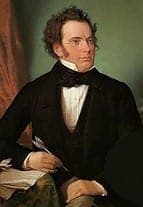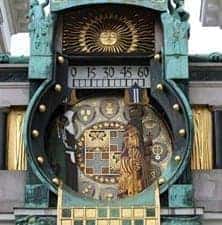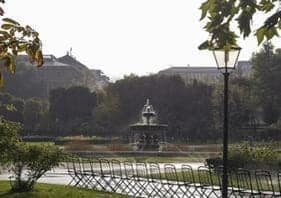Where was Franz Schubert born and how old was he? What did he die of? What was it about his glasses? How did he live and what did he leave for posterity? Who was he so eager to be buried next to?
On January 31, 1797 , Franz Peter Schubert saw the light of day at Nußdorfer Strasse 54 (at Himmelpfortgrund). His birthplace can still be visited today, as can his death house in Kettenbrückengasse in the 4th district. Both are administered by the Wien Museum.
His father was a schoolmaster and taught him to play the violin at the tender age of five. He received organ lessons in the Lichtenthal parish church . When he is 15 years old, his mother died and his father remarried. Schubert thus had a total of about 18 siblings/half-siblings.
Because of his beautiful voice, he joined the Boys’ Choir . There he also received lessons from Antonio Salieri and met long-time friends such as Joseph von Spaun, Albert Stadler and Anton Holzapfel . His talent lay in composition as soon became apparent.
For his father’s sake, he initially began working for him as a school assistant, but he soon realized that this was not his direction. He preferred to compose, for example, the “Gretchen am Spinnrad”, the
“Heideröslein” or the “Erlkönig”.
His father was not very empathetic and Schubert’s friends became his family . He moved out of home early and always lived in shared apartments. He was not good at being alone. Especially with Franz von Schober he cultivated a close friendship. He creates a dream world for himself with his music.
His circle of friends expanded more and more, e.g. to the Kupelwieser brothers or Moritz von Schwind . The musical family Sonnleithner organized musical gatherings in his honor , which culminated from 1821 in the Schubertiades , which are still known today.
Schubert was prone to alcohol consumption, corpulence and this had a negative effect on his health. He suffered from a venereal disease, the dreaded syphillis , and was treated for ulcers at the AKH in 1823.
In 1824 he succeeded in composing the famous song cycle “Die schöne Müllerin”. One of Schubert’s peculiarities was his glasses, which he allegedly did not even take off at night to sleep, as he always wanted to have them handy for composing.
Franz Schubert died on November 19, 1829 in the house of his brother Ferdinand in Kettenbrückengasse. The death house can still be visited today. He suffered from syphillis, but the cause of death may have been typhoid fever .
Franz Schubert lived only 31 years and in this short time he was very productive. He left behind over 600 songs, choral music, overtures and symphonies. He said about himself “He came into the world only to compose and nothing else”.
Compared to Beethoven, Haydn and Mozart , Schubert is often considered a misunderstood genius. He did not achieve the impact with his symphonies and operas because he did not seek publicity. Persuaded by his friends, he gave a concert in 1827 that was very successful. His masterpiece was the 600 songs in which he turned poetry into music.
He was a great admirer of Beethoven and was eager to be buried next to him. Both were first buried at the Währinger Cemetery and later both received an honorary grave next to each other at the Vienna Central Cemetery.
In the city park you will find a monument to Schubert . In the State Opera Moritz von Schwind created a Schubert lunette . The Schubert-Ring in the first district, the Schubertgasse in the 9th district and the Franz-Schubertgasse in the 14th district were named after him.
Time Travel Tip: Visit Franz Schubert’s birthplace at Nußdorfer Straße 54 or his death residence at Kettenbrückengasse 6 to gain more insight into his life. Every 1st Sunday of the month you get free admission there!
More info: Schubert Birthplace : WIEN MUSEUM




